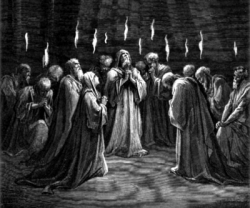
In the first post of this series I highlighted the unity of Luke-Acts. I emphasized that the two books seem to show us that the ministry of Jesus is continued through his Church. Now I want to begin to move closely through the narrative, highlighting the way this theological truth is underscored.
Indeed, for the reader who knows the Gospel of Luke, Acts is a sort of déjà vu experience. The narrative in Acts virtually replicates what is found in Luke. In sum, as Talbert demonstrates, the life of the Church in Acts mirrors―in often striking ways!―the public life of Christ in Luke. In this post I’ll look at the first half of the Book of Acts, highlighting 6 major ways Luke and Acts parallel each other.
1. Baptism and the coming of the Spirit
In Luke, Jesus is baptized in the Jordan and, after he prayed, the Holy Spirit comes down upon him in visible form, the form of a dove (Luke 3:22).
In Acts, Jesus’ promise that the disciples will be “baptized with the Holy Spirit” (cf. Acts 1:5) is fulfilled as, after having been gathered in prayer (Acts 1:14), the Spirit comes upon them at Pentecost, appearing over them in visible form, i.e., tongues of fire (Acts 2:1–4).
2. Ministry commences with a speech
In Luke, Jesus’ public ministry commences at Nazareth with Jesus speaking in a synagogue (Luke 4:14–21). The message is clear: Jesus is bringing fulfillment to Isaiah’s prophecy. The people speak well of him and wonder at his words (Luke 4:22). There however he is ultimately rejected. Despite the opposition though Jesus is delivered from the hands of those who want to kill him (Luke 4:28–30).
In Acts, the Church’s ministry commences on Pentecost as Peter speaks in the temple (Acts 2:14–36). The message is clear: Jesus, the Messiah, came, yet despite being rejected, he has been exalted by God. Many accept Peter’s message (Acts 2:37). However, as the narrative unfolds we read that Jewish leaders reject the apostles and seek to destroy them. They are, however, miraculously delivered (cf. Acts 12:6–11).
3. Healing
In Luke, Jesus’ ministry begins with a series of miraculous events, e.g., the healing of a man who is unable to walk and who must be brought to Jesus carried on his mat (cf. Luke 5:17–26).
In Acts, the apostles’ ministry begins with miraculous signs. Peter, in fact, heals a lame man (cf. Acts 3:1–10).
4. Conflict with Jewish leaders
In Luke, as Jesus’ public ministry continues, he runs into conflict with the Jewish leaders (cf. e.g., Luke 5:29–6:11).
In Acts, as the apostles’ ministry is opposed by the same Jerusalem establishment (cf. Acts 4:1–8:3).
5. Appointing leaders
In Luke, Jesus goes on to appoint twelve apostles (Luke 6:12–16) and then, later, seventy-two disciples (Luke 10:1).
In Acts the apostles appoint, not only a successor for Judas (cf. Acts 1) but also seven deacons (Acts 6:1–6).
5. Jesus and St. Stephen
In Luke, at the end of his life, Jesus was arrested, made to stand trial, was questioned by the high priest, was falsely accused and executed. The climactic moment of Jesus’ trial comes as Jesus tells the high priest he will see the Son of Man coming on the clouds of heaven and reveals his identity as the Son of God (Luke 22:69–70). Immediately after this he is condemned to death (Luke 22:71).
In Acts, Stephen is arrested, made to stand before the council, accused by false witnesses of claiming Jesus would destroy the temple (a claim leveled against Jesus in Matthew and Mark), questioned by the high priest, and executed. Stephen’s trial climaxes with his statement: “Behold, I see the heavens opened, and the Son of man standing at the right hand of God” (Acts 7:56). After this, he is killed.
Of course, Stephen is even described like Jesus in death. Just before dying Jesus prays, “Father, into thy hands I commit my spirit!” (Luke 23:46). Stephen likewise prays, “Lord Jesus, receive my spirit” (Acts 7:59). Moreover, when Jesus is crucified he prays, “Father, forgive them; for they know not what they do” (Luke 23:34). Similarly, Stephen prays for his accusers: “Lord, do not hold this sin against them” (Acts 7:60). In fact, here I have to mention St. Augustine’s line: “Had Stephen not prayed, the Church today would have no Paul”.
6. Peter’s deliverance
The story of Peter’s deliverance from prison in Acts 12 also seems to parallel the story of Jesus in a certain way. Jesus was delivered from death.
In Luke, it is women who are the first witnesses to the resurrection. Instructed by angels, they go and tell the disciples that Jesus has been raised from the dead (Luke 24:1–10). However, the disciples do not believe them (Luke 24:11).
In Acts, Peter is delivered from prison, having been arrested after the martyrdom of James. It seems clear that he about to be executed (cf. Acts 12:1–2). Peter is then delivered by an angel―in a certain sense, he is delivered from death too. The first witness to his deliverance is a woman. She goes and tells the disciples that she has seen him but they do not believer her (cf. Acts 12:15).